Hi people
I am looking for references or links to styles of handles used on small broken back Anglo Saxon seaxes.
I understand that wood was the main if not only type of material used, Am interested in seeing any examples of historically accurate handles and examples of handles with a small amount of authors licence.
Any pics or links would be greatly appreciated.
Kind regards
Jason
Jason-
There are some links to some great historical pieces and some with a bit of artistic license in the links section here on myArmoury. Check out the following links in particular:
Jake Powning
JT Palikko
Also check out Eric McHugh's page in Albion's "in house artisan" section. He makes very well researched and excellent seaxes!
Two more sites that are cool but not in the links page are:
http://www.thorkil.ovh.org/knives.htm
http://jfmetalsmith.com/seaxes.html
I'm also attaching a photo of some carved seax handles that you may appreciate!
-Tim
 Attachment: 21.1 KB
Attachment: 21.1 KB
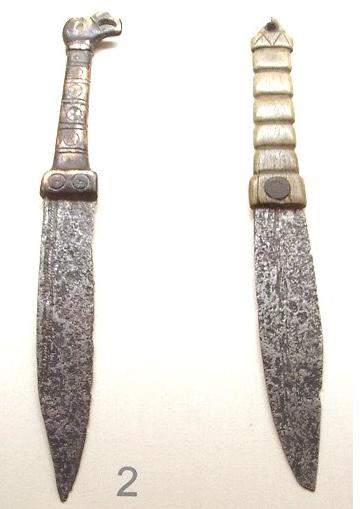
There are some links to some great historical pieces and some with a bit of artistic license in the links section here on myArmoury. Check out the following links in particular:
Jake Powning
JT Palikko
Also check out Eric McHugh's page in Albion's "in house artisan" section. He makes very well researched and excellent seaxes!
Two more sites that are cool but not in the links page are:
http://www.thorkil.ovh.org/knives.htm
http://jfmetalsmith.com/seaxes.html
I'm also attaching a photo of some carved seax handles that you may appreciate!
-Tim

great stuff! Thanks Tim!!!
Cheers
Jason
Cheers
Jason
| J Anstey wrote: |
| great stuff! Thanks Tim!!!
Cheers Jason |
Mind that the saxes in that picture are really small knives, only about 17-18cm total length IIRC. Larger saxes, if any hilt material survives, it's wood. The small sax or narrow sax type sometimes has metal bolsters and pommels. Most other types of saxes however didn't. For more information:
http://1501bc.com/files/information_about_saxes.zip
B.t.w. interesting worth mentioning, I've come accross a reference of a sax found in the Netherlands which has remains of leather covering the wooden grip. I can't verify yet what type of sax it is, but I suspect it's one of the narrow saxes with metal pommel and bolster. I still have to trace down the publication of that particular sax.
Thanks again for all you help Jeroen.
With seaxes we have mostly only blades surviving.
In most cases there are at most traces of of the leather from scabbards sometimes and sometimes traces of wood of the grips.
We have to build our idea of how they looked based on the remains and those are pretty meagre.
We might conclude that the only possible solution is to make the grip a plain and unadorned wooden grip. Personally, I think that is not the most realistic solution, even though the finds rarely supports anything further than that.
I have run across a number of seaxes in museum store rooms. I have documented perhaps forty of different type and from different time periods. In Uppsala where I live there is the store room of the Univesity collection where many of the finds from Vendel and Valsgärde are kept. These are rather special and perhaps unique. It is difficult to say how much they tell of seaxes from other parts of Europe. What they show hints at a rather rich and flamboyant expression, rather than the stark and simplistic.
The weapons from Vendel and Valsgärde are unusually well preserved. You can see how the scabbards are constructed and decorated. They are built with a wooden core made up from four parts. These are leather covered and adorned with decorative nails and/or panels with zoomorphic knotwork. At times the inside of the scabbards are lined with fur.
The front side of the wood cores are sometimes carved with knotwork, that show through the thin leather that is glued on top.
This is a method of decoration that can be observed on other seax scabbards (finds from Gotland for example). The very same technique is found on late roman and early migration period sword scabbards: skillful and intricate carving of the wood that is overlayed with very thin and fine leather.
The grips of the seaxes from Vendel and Valsgärde have wood cores and in at least one case, the core is made up from two halves that are glued together (like the grip core of a Japanese sword). The grips are then covered with thin leather and in several cases decorated with geometric patterns of silver or bronze nails (with domed hollow heads). The effect of this nail decoration is rather similar to that you can see on the rifles of the Indians of the ”wild west” in the 19th C.
In some cases there are remains of bronze mounts on the grips. One or two cases of rivet blocks (an unusual feature), but there are also discolorations of the leather that makes me think that there could once have been thin strips of bronze at the forward and perhaps aft end of the grips, over the leather. This is a guess, but it makes sense if the grip was made in two halves and glued together.
In archaeological reports you can sometimes see that there are remains of glue and animal hair wrapped around the tang of seaxes. I think this is the remains of a hollow bone grip that was secured with a mixture of glue and hair. The bone is gone and only the glue/hair mix remains.
Once I did a reconstruction of the contents of a warrior grave excavated just north of Stockholm, Tomteboda. There was a seax of unusual shape, that proved to be interesting. In photos of the excavation you can make out the seax in situ. You can see the outline of the scabbard and the grip and discolorations where there were oxides from metal mounts.
In the earth you could see traces of corrosion in bands across the scabbard, suggesting a mouth band and a chape and reinforcing bands along each side. There was also discolorations in the grip area. Nothing solid had survived to study however. It was all just dirt with inclusions of salts and rust.
The scabbard seems to be of similar type as those well preserved examples from Vendel/Valsgärde. Conservation report told of traces or remains of hair (from deer) and glue wrapped around the tang of that was cleaned away from the blade during conservation.
The grip did not survive, but there were details in the corrosion close to the end of the tang (that had been bent over the end of the grip) showing there had been rivets securing some kind of mounting at the end of the grip.
If I were to offer a personal guess at the original design of the grip, I would say that it had a wooden core, metal reinforcing band at the ends, a carved knot work decoration that was covered with thin leather.
For the actual reconstruction we had to be strict with the interpretation, so a simple bare wood grip with a reinforcing "cap" or band at the rivet end was made. I am not convinced that was how the weapon actually did look.
To interpret the meagre material remaining of the mounting of seaxes we have to try to draw conclusions from parallel finds. I think it is reasonable to look at other types of scabbards and knives. It is common to see decorative features, often as carvings. Nothing of this remains, even in those cases where there are traces of wood sticking to the tang. To make a representation of the grip as a very bare and simple ting, might be actually less realistic and authentic.
There are some grips preserved showing what the carved decoration might have looked like.
I think most of these are from scandinavian areas. The decorative style would naturally be scandinavian. Still, I think many (most?) seaxes from Germanic or Anglo-saxon areas were also decorated, at least with carving and possibly with thin metal mounts as well. If we choose to include such features, we need to look carefully at the decorative style of the region and period and we need to keep in mind that it is a suggestion to a solution. Not fact. To exclude such features might result in less realism, not more. It is a difficult dilemma.
The thing is that making reconstructions of seaxes, we *always* have to rely to some extent to guesswork. Only few examples have survived that hint at something more than blade shape. We know very little about the actual shape of the grips. There are some tantalizing hints in surviving material, but these show only details and only very few examples.
To say, based on surviving material, that seaxes *always* had simple wood grips is to me an exaggeration. We cannot know this is true. We have little support for the actual design and possible decoration, but to assume they were plain, simply because the surviving material is meagre or prove littel in the way otherwise, seems to me a misleading conclusion.
We know we do not know a lot about them.
Choosing a safe road including only the known might in this case lead us astray.
It is noteworthy that in many of those few cases were origial surface *does* survive, there is decoration and metal mounts involved.
We need to look at other weapons of the period.
We need to consider the decorated spear and arrow shafts in Danish material (they have painted and carved decorations).
We need to consider carved and embellished grips of smaller knives that can hint at decorative features used for seaxes.
We need to look at the decoration of surviving leather scabbards in the germanic material.
When this is all put into the picture, we might be able to suggest a *possible* solution for the design and construction of the grips of seaxes. We will never know for sure, unless there is a complete find. And then we will know what *one* seax looked like.
Jeroen, I am very much with you as you stress the importance of studying details and types. It is very easy to be led astray in the interpretation if we do not consider how well developed and specific this weapon was and how it evolved over the centuries. I am however also suggesting that we need to include a certain degree of calculated interpretation when it comes to mounting of the grip and the scabbard. So little remains today, that we need to rely on contemporary items to get a full picture.
I would suggest that the simple wood grip, might not be that simple ;-)
I would even go so far to suggest that to put a simple un adorned wood grip on a fine seax blade might not be very authentic.
We cannot know what it would have looked like for certain, but the material suggests a love for decoration and contrast in materials and colors. It is up to us to develop a sensible suggestion based on the complete material from the period.
In most cases there are at most traces of of the leather from scabbards sometimes and sometimes traces of wood of the grips.
We have to build our idea of how they looked based on the remains and those are pretty meagre.
We might conclude that the only possible solution is to make the grip a plain and unadorned wooden grip. Personally, I think that is not the most realistic solution, even though the finds rarely supports anything further than that.
I have run across a number of seaxes in museum store rooms. I have documented perhaps forty of different type and from different time periods. In Uppsala where I live there is the store room of the Univesity collection where many of the finds from Vendel and Valsgärde are kept. These are rather special and perhaps unique. It is difficult to say how much they tell of seaxes from other parts of Europe. What they show hints at a rather rich and flamboyant expression, rather than the stark and simplistic.
The weapons from Vendel and Valsgärde are unusually well preserved. You can see how the scabbards are constructed and decorated. They are built with a wooden core made up from four parts. These are leather covered and adorned with decorative nails and/or panels with zoomorphic knotwork. At times the inside of the scabbards are lined with fur.
The front side of the wood cores are sometimes carved with knotwork, that show through the thin leather that is glued on top.
This is a method of decoration that can be observed on other seax scabbards (finds from Gotland for example). The very same technique is found on late roman and early migration period sword scabbards: skillful and intricate carving of the wood that is overlayed with very thin and fine leather.
The grips of the seaxes from Vendel and Valsgärde have wood cores and in at least one case, the core is made up from two halves that are glued together (like the grip core of a Japanese sword). The grips are then covered with thin leather and in several cases decorated with geometric patterns of silver or bronze nails (with domed hollow heads). The effect of this nail decoration is rather similar to that you can see on the rifles of the Indians of the ”wild west” in the 19th C.
In some cases there are remains of bronze mounts on the grips. One or two cases of rivet blocks (an unusual feature), but there are also discolorations of the leather that makes me think that there could once have been thin strips of bronze at the forward and perhaps aft end of the grips, over the leather. This is a guess, but it makes sense if the grip was made in two halves and glued together.
In archaeological reports you can sometimes see that there are remains of glue and animal hair wrapped around the tang of seaxes. I think this is the remains of a hollow bone grip that was secured with a mixture of glue and hair. The bone is gone and only the glue/hair mix remains.
Once I did a reconstruction of the contents of a warrior grave excavated just north of Stockholm, Tomteboda. There was a seax of unusual shape, that proved to be interesting. In photos of the excavation you can make out the seax in situ. You can see the outline of the scabbard and the grip and discolorations where there were oxides from metal mounts.
In the earth you could see traces of corrosion in bands across the scabbard, suggesting a mouth band and a chape and reinforcing bands along each side. There was also discolorations in the grip area. Nothing solid had survived to study however. It was all just dirt with inclusions of salts and rust.
The scabbard seems to be of similar type as those well preserved examples from Vendel/Valsgärde. Conservation report told of traces or remains of hair (from deer) and glue wrapped around the tang of that was cleaned away from the blade during conservation.
The grip did not survive, but there were details in the corrosion close to the end of the tang (that had been bent over the end of the grip) showing there had been rivets securing some kind of mounting at the end of the grip.
If I were to offer a personal guess at the original design of the grip, I would say that it had a wooden core, metal reinforcing band at the ends, a carved knot work decoration that was covered with thin leather.
For the actual reconstruction we had to be strict with the interpretation, so a simple bare wood grip with a reinforcing "cap" or band at the rivet end was made. I am not convinced that was how the weapon actually did look.
To interpret the meagre material remaining of the mounting of seaxes we have to try to draw conclusions from parallel finds. I think it is reasonable to look at other types of scabbards and knives. It is common to see decorative features, often as carvings. Nothing of this remains, even in those cases where there are traces of wood sticking to the tang. To make a representation of the grip as a very bare and simple ting, might be actually less realistic and authentic.
There are some grips preserved showing what the carved decoration might have looked like.
I think most of these are from scandinavian areas. The decorative style would naturally be scandinavian. Still, I think many (most?) seaxes from Germanic or Anglo-saxon areas were also decorated, at least with carving and possibly with thin metal mounts as well. If we choose to include such features, we need to look carefully at the decorative style of the region and period and we need to keep in mind that it is a suggestion to a solution. Not fact. To exclude such features might result in less realism, not more. It is a difficult dilemma.
The thing is that making reconstructions of seaxes, we *always* have to rely to some extent to guesswork. Only few examples have survived that hint at something more than blade shape. We know very little about the actual shape of the grips. There are some tantalizing hints in surviving material, but these show only details and only very few examples.
To say, based on surviving material, that seaxes *always* had simple wood grips is to me an exaggeration. We cannot know this is true. We have little support for the actual design and possible decoration, but to assume they were plain, simply because the surviving material is meagre or prove littel in the way otherwise, seems to me a misleading conclusion.
We know we do not know a lot about them.
Choosing a safe road including only the known might in this case lead us astray.
It is noteworthy that in many of those few cases were origial surface *does* survive, there is decoration and metal mounts involved.
We need to look at other weapons of the period.
We need to consider the decorated spear and arrow shafts in Danish material (they have painted and carved decorations).
We need to consider carved and embellished grips of smaller knives that can hint at decorative features used for seaxes.
We need to look at the decoration of surviving leather scabbards in the germanic material.
When this is all put into the picture, we might be able to suggest a *possible* solution for the design and construction of the grips of seaxes. We will never know for sure, unless there is a complete find. And then we will know what *one* seax looked like.
Jeroen, I am very much with you as you stress the importance of studying details and types. It is very easy to be led astray in the interpretation if we do not consider how well developed and specific this weapon was and how it evolved over the centuries. I am however also suggesting that we need to include a certain degree of calculated interpretation when it comes to mounting of the grip and the scabbard. So little remains today, that we need to rely on contemporary items to get a full picture.
I would suggest that the simple wood grip, might not be that simple ;-)
I would even go so far to suggest that to put a simple un adorned wood grip on a fine seax blade might not be very authentic.
We cannot know what it would have looked like for certain, but the material suggests a love for decoration and contrast in materials and colors. It is up to us to develop a sensible suggestion based on the complete material from the period.
| Peter Johnsson wrote: |
| Jeroen, I am very much with you as you stress the importance of studying details and types. It is very easy to be led astray in the interpretation if we do not consider how well developed and specific this weapon was and how it evolved over the centuries. I am however also suggesting that we need to include a certain degree of calculated interpretation when it comes to mounting of the grip and the scabbard. So little remains today, that we need to rely on contemporary items to get a full picture.
I would suggest that the simple wood grip, might not be that simple ;-) I would even go so far to suggest that to put a simple un adorned wood grip on a fine seax blade might not be very authentic. We cannot know what it would have looked like for certain, but the material suggests a love for decoration and contrast in materials and colors. It is up to us to develop a sensible suggestion based on the complete material from the period. |
Hi Peter. I agree with you on the possible error that you may get for using plain, undecorated hilts, but there are two reasons why I wouldn't decorate them. One is the hunting knife of Charlemagne. This broken back style sax is virtually complete. The blade is of the most complex construction, with a triple billets of torsion damast, and a saw tooth welded edge. The scabbard is the most complex decorated one I've seen, with a very detailed embossed decoration in the leather work, and metal fittings on the scabbard. However, the hilt is a plane, and undecorated piece of wood (with metal ferrule, but that may be a later addition). If such a high end piece has a simple hilt, then I'd assume the more simple ones generally had as well. I know there are non-typical saxes or knives of various types from the same period that do have decorated hilts though, most often with bird heads at the end. So that's a possibility, but I personally wouldn't apply it to other types of saxes/knives.
The second reason not to decorate hilts, even if there's a hint that they might have been is because you add a decoration that almost certainly is wrong, and IMO introduces many more errors then no decoration. Decoration is also the first thing that catches the eye, so I rather have the first things to catch the eye be what's certain from archeological evidence. I know this from living history that it's very important to keep the public's focus to what's known, and not to what's fantasy. Otherwise the people will only see the fantasy bits, and all the effort on making everything else perfectly authentic will get unnoticed. For me, a reconstruction is a representation of archeological knowledge, so I keep the gaps I fill in as simple and plain as possible. That's generally my personal preference, although I have made some exceptions to it myself as well. Someone else may prefer to make a reconstruction look as flashy and eye catching as possible instead, even if using all archeological data. That's also useful to show what could have been. Different approaches are possible :)
| Jeroen Zuiderwijk wrote: |
| [ For me, a reconstruction is a representation of archeological knowledge, so I keep the gaps I fill in as simple and plain as possible. That's generally my personal preference, although I have made some exceptions to it myself as well. Someone else may prefer to make a reconstruction look as flashy and eye catching as possible instead, even if using all archeological data. That's also useful to show what could have been. Different approaches are possible :) |
Yes, I can absolutely respect that approach and it is a modus operandi I often use myself for many projects.
I think it is still important to be clear that the decorated grip has as much support as the plain one (If not more).
With the rarity of remaining evidence any conclusion we make is bound to have limited valu. Even a plain grip applied as a blanket solution for all cases, will be an assumption based on limited material: an interpretation as much as built on fact.
If I base a reconstruction on material from the Vendel/Valsgärde material, I get another expression, than if I use the hunting knife of Charlemagne as the basis of my work.
Both approaches build on the foundation of a few cases of preserved material. Both cases only show a small window of what might have been.
I get the impression from what you write that you think the plain grip is the *only* sustainable solution. That is not supported by the preserved material to my mind.
In both cases it is important to be clear about the nature of the work: what is known and what is assumed. To say that there is proof that seax grips were always plain and unadorned wood is misleading.
There are cases telling another story. How far you take that evidence is a matter of interpretation.
I simply want to point out that there are things we can know about seaxes and some aspect we will never know for certain.
We can only make assumptions based on limited data in those cases. To go with plain might be as wrong as adding decoration. The plain solution might seem safer, but it can be more misleading. We do not know and so we need to be clear about what is assumed and what is based on observed fact.
If I base the decoration of a grip on those remains from the finds from Vendel/Valsgärde or Gotland you cannot say the decoration is surely wrong. It is absolutely associated with the the type and supported by archaeological finds.
Last edited by Peter Johnsson on Tue 18 Dec, 2007 8:36 am; edited 1 time in total
Here's perhaps a reasonable amount of license on a Frankish sax I made in '05, stealing design elements from sword grips... (wood, iron, silver)
And here is an extreme amount of license, from earlier this year, inauthentic to the Nth degree but a lot of fun to make and use :D (carved oosik)
Both on large saxes, but that's all I got to contribute, perhaps some scale-able elements to them ;)
I think more contemporary saxes need leather covered grips.
 Attachment: 33.24 KB
Attachment: 33.24 KB
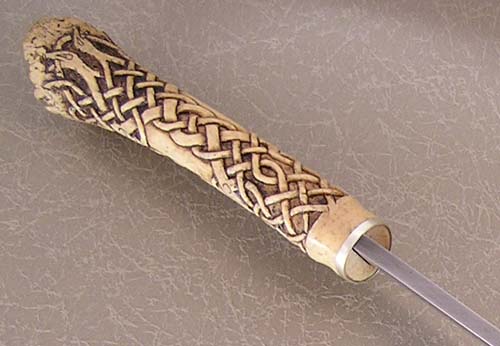
 Attachment: 62.84 KB
Attachment: 62.84 KB
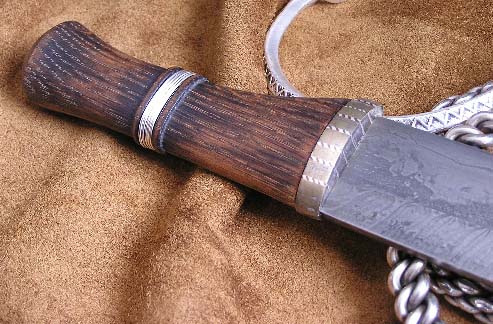
And here is an extreme amount of license, from earlier this year, inauthentic to the Nth degree but a lot of fun to make and use :D (carved oosik)
Both on large saxes, but that's all I got to contribute, perhaps some scale-able elements to them ;)
I think more contemporary saxes need leather covered grips.


Well, if one had to be 100 sure of not making a mistake one could leave the seax with a naked tang, but that would be sort of giving up !
Plain handle is a default but what shape of wooden handle one could ask !
1) Plain cylindrical or oval section or octagonal ?
2) Waisted or bulged ?
3) Carved, grooved, ridged bands ?
4) Wooden bulges at guard or pommel like a later ballock dagger, but still just a plain wood handle ?
Just a thought that plain wood handles could be almost as problematic as adding metal bands or wire wraps or leather or cord coverings. ( Not suggesting that any of these were used as I don't know the subject well enough ).
So for a strictly historical seax there are a lot of uncertainties and I guess the case can be made that a simple handle is at least the least error prone solution and is just a " stand in " for what the real handles might have looked like.
For an " ART KNIFE " based on a seax one can " invent/create " what one wants, it's just good to be clear what one is trying to accomplish.
Plain handle is a default but what shape of wooden handle one could ask !
1) Plain cylindrical or oval section or octagonal ?
2) Waisted or bulged ?
3) Carved, grooved, ridged bands ?
4) Wooden bulges at guard or pommel like a later ballock dagger, but still just a plain wood handle ?
Just a thought that plain wood handles could be almost as problematic as adding metal bands or wire wraps or leather or cord coverings. ( Not suggesting that any of these were used as I don't know the subject well enough ).
So for a strictly historical seax there are a lot of uncertainties and I guess the case can be made that a simple handle is at least the least error prone solution and is just a " stand in " for what the real handles might have looked like.
For an " ART KNIFE " based on a seax one can " invent/create " what one wants, it's just good to be clear what one is trying to accomplish.
Hello everyone,
I and Tod of Tod's stuff are in the middle of a commission of a late period broken back seax (1000-1100) sharing blade proportions with the honey lane example in London. Blade will be 7-8 mm. thick- with a wrought iron blade and steel folded edge. There will be both silver and copper inlay on the blade and maybe- if it is authentic going down the top of the spine. We are also thinking of some file work on the spine but this has not been finalized. We are doing our best to come up with as authentic an example as we can, but as Peter has stated- intact grip material is meager.
Regarding the grip we plan for a box wood slightly waisted grip with no other metal in the hilt. Tod will apply decorative carving to the grip. I have no knowledge of authentic wood carving so I leave this to him.
Peter, or others,
If you see any glaring inaccuracies with the above description please let me know as I want to get this as right as I can.
Thanks,
Jeremy
I and Tod of Tod's stuff are in the middle of a commission of a late period broken back seax (1000-1100) sharing blade proportions with the honey lane example in London. Blade will be 7-8 mm. thick- with a wrought iron blade and steel folded edge. There will be both silver and copper inlay on the blade and maybe- if it is authentic going down the top of the spine. We are also thinking of some file work on the spine but this has not been finalized. We are doing our best to come up with as authentic an example as we can, but as Peter has stated- intact grip material is meager.
Regarding the grip we plan for a box wood slightly waisted grip with no other metal in the hilt. Tod will apply decorative carving to the grip. I have no knowledge of authentic wood carving so I leave this to him.
Peter, or others,
If you see any glaring inaccuracies with the above description please let me know as I want to get this as right as I can.
Thanks,
Jeremy
| Peter Johnsson wrote: |
| With the rarity of remaining evidence any conclusion we make is bound to have limited valu. Even a plain grip applied as a blanket solution for all cases, will be an assumption based on limited material: an interpretation as much as built on fact.
If I base a reconstruction on material from the Vendel/Valsgärde material, I get another expression, than if I use the hunting knife of Charlemagne as the basis of my work. |
That's true, but judging from the comparisson of the remains I've seen from Sweden, they are very different from the rest Europe. The blades of Swedish knives are very different, they have very different metal hilt components and quite a few have bone hilt remains. So I would keep information of the Swedish examples separated from the rest of Europe.
| Quote: |
| Both approaches build on the foundation of a few cases of preserved material. Both cases only show a small window of what might have been.
I get the impression from what you write that you think the plain grip is the *only* sustainable solution. That is not supported by the preserved material to my mind. |
I'm not saying that all saxes had plain hilts. However, the Charlemagne sax shows that a plane hilts were used, and that a heavy decorated blade and scabbard don't mean that the hilt would be decorated.
| Quote: |
| In both cases it is important to be clear about the nature of the work: what is known and what is assumed. To say that there is proof that seax grips were always plain and unadorned wood is misleading. |
Don't worry, I know well how to separate assumptions from facts :) I'm pretty well trained in this in my dayjob, where such things are even much more crucial then in archeology (where things don't crash when you guessed wrong!). In case of broken back style saxes, I won't apply decorated hilts, which conflict with the one example that is completely preserved. For other style saxes, it's less likely to be correct, but until I've got more information I will go for relatively simple shapes as well.
| Quote: |
| I simply want to point out that there are things we can know about seaxes and some aspect we will never know for certain.
We can only make assumptions based on limited data in those cases. To go with plain might be as wrong as adding decoration. The plain solution might seem safer, but it can be more misleading. We do not know and so we need to be clear about what is assumed and what is based on observed fact. |
Exactly. For Frankish langsaxes f.e., what I know is that hilts were wood, and the longest, still incomplete hilt is 20cm in length. As I have no information about the original surface and shape so there I have to guess. But as the Charlemagne sax has also has the long, wooden hilt, and is from close to the same period, I use that to fill in the gaps. Also, I look at reconstruction drawings in the archeological report. They may have had more information then I have to make those reconstructions, so I use that as imput as well. It's all educated guesswork. This educated guesswork is not just random guessing, but actually takes the most effort by far. You have to be sure to have every bit of archeological information available, then know the whole range of options, and determine the likelyhood of each option based on every indication from the archeological information available. That results in a best guess, which may be turned upside down when new information becomes available. For that reason f.e. I find it highly frustrating that I can't look at any of the dutch langsaxes to see if I can spot remains of the original surface of the hilts of these langsaxes. Just a single patch of surface can already give me a wealth of extra information to make more accurate reproductions.
| Jean Thibodeau wrote: |
| Well, if one had to be 100 sure of not making a mistake one could leave the seax with a naked tang, but that would be sort of giving up !
Plain handle is a default but what shape of wooden handle one could ask ! |
Much to choose from, and virtually no evidence to support any :) Still though:
| Quote: |
| 1) Plain cylindrical or oval section or octagonal ? |
I'd go for oval, or flattened oval. Reasons: Charlemagne sax (oval cross section)
| Quote: |
| 2) Waisted or bulged ? |
Straight. Reason: Tombstone from Niederdollendorf (see: http://1501bc.com/files/06210012.jpg), Germany (also shows a possible hole near the end of the hilt)
| Quote: |
| 3) Carved, grooved, ridged bands ? |
Smooth, same reason as above. Also, it's reconstructed this way in archeological publications. They probably have more information then me, so unless I have reasons to doubt the reconstruction, I go with that.
| Quote: |
| 4) Wooden bulges at guard or pommel like a later ballock dagger, but still just a plain wood handle ? |
For langsaxes, the wood has to expand near the blade, as the tang is quite wide. However, as the hilt goes into the scabbard, not much can protrude from the hilt. So no significant bulges. Also for broken back saxes, several scabbards are found which were closely shaped around the hilt, showing that simple hilt shapes as on the Charlemagne sax were applied there as well.
Finally, there are various other single edged weapons with long, simple shaped hilts throughout history and in different cultures. This shows that such hilts do work practically. It also shows that the wood was frequently covered. So a leather cover over the wood f.e. is not unlikely.
| Quote: |
| For an " ART KNIFE " based on a seax one can " invent/create " what one wants, it's just good to be clear what one is trying to accomplish. |
Yeah, that's why I generally don't like when they are called saxes, as they are different things, which may have some inspiration from saxes. To me it feels like calling Conan the Barbarian's sword a Viking sword.
Here are a few images I have of Seax with grip material....
ks
 Attachment: 57.63 KB
Attachment: 57.63 KB
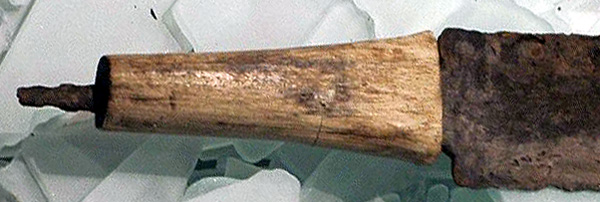
Bone Grip .NydamIV Bog Find. 450-475 A.D. Detail from Photo By Jeroen Zuiderwijk
 Attachment: 99.85 KB
Attachment: 99.85 KB
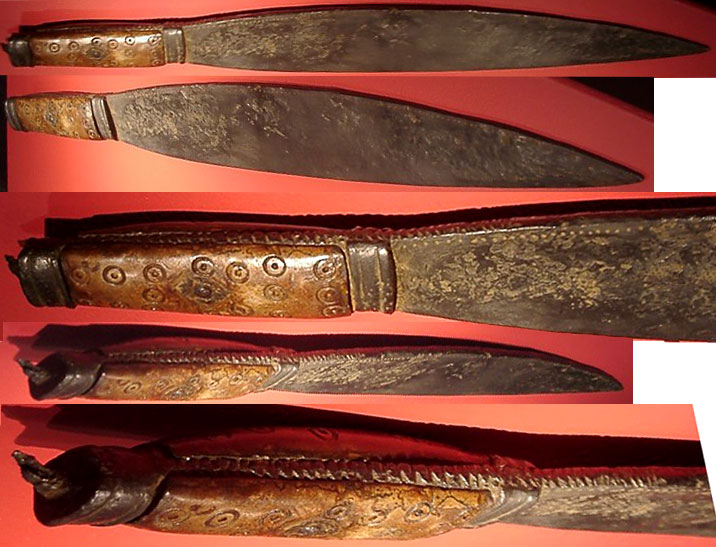
Bone Grip with inscribed Circles. Rijksmuseum van Oudheden, Leiden Netherlands Compiled from photos by Jeroen Zuiderwijk
 Attachment: 147.94 KB
Attachment: 147.94 KB
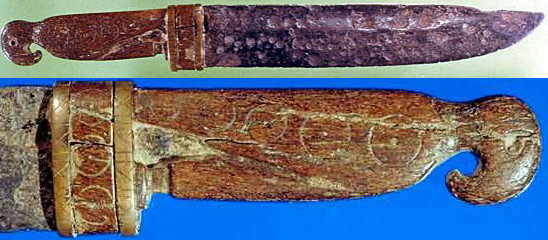
Wood Grip Raven Design incribed Circles. Netherlands 9th century Length 30cm Image from "Medieval Warfare Source Book Vol. 1 Warfare in Western Christendom"
 Attachment: 90.47 KB
Attachment: 90.47 KB
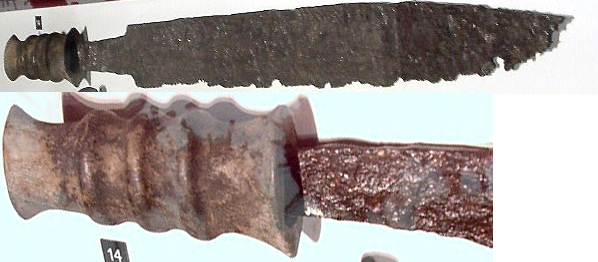
Bone Grip Compiled from images by Jeroen Zuiderwijk
 Attachment: 98.79 KB
Attachment: 98.79 KB
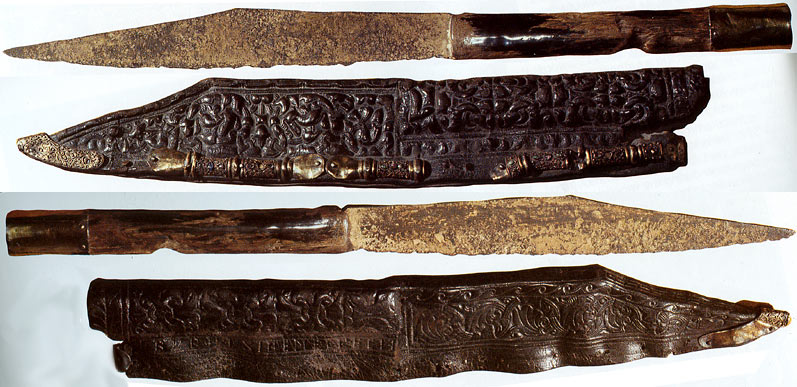
Knife Of Charlemagne. HornGrip. AechenGermany. Length 53cm Blade 31cm Blade Width 45mm Grip Length 22cm Max. Thickness 3.6mm. Image from "Damascus Steel"by Manfred Sachse
 Attachment: 99.96 KB
Attachment: 99.96 KB
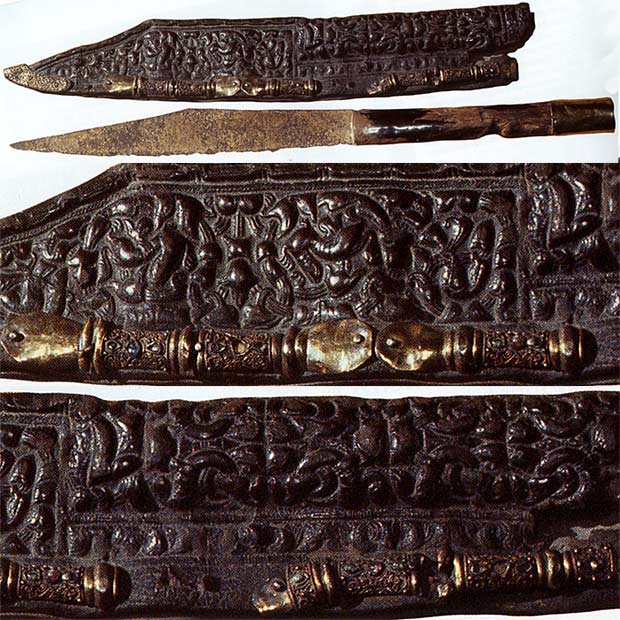
Knife of Charlemagne. Close up of Scabbard. Image from "Damascus Steel"by Manfred Sachse
ks

Bone Grip .NydamIV Bog Find. 450-475 A.D. Detail from Photo By Jeroen Zuiderwijk

Bone Grip with inscribed Circles. Rijksmuseum van Oudheden, Leiden Netherlands Compiled from photos by Jeroen Zuiderwijk

Wood Grip Raven Design incribed Circles. Netherlands 9th century Length 30cm Image from "Medieval Warfare Source Book Vol. 1 Warfare in Western Christendom"

Bone Grip Compiled from images by Jeroen Zuiderwijk

Knife Of Charlemagne. HornGrip. AechenGermany. Length 53cm Blade 31cm Blade Width 45mm Grip Length 22cm Max. Thickness 3.6mm. Image from "Damascus Steel"by Manfred Sachse

Knife of Charlemagne. Close up of Scabbard. Image from "Damascus Steel"by Manfred Sachse
Wow!
Thanks to all of the very knowledgeable people that have answered so thoroughly I am blown away by the depth of knowledge here.
Cheers
Jason
Thanks to all of the very knowledgeable people that have answered so thoroughly I am blown away by the depth of knowledge here.
Cheers
Jason
| Kirk Lee Spencer wrote: |
| Here are a few images I have of Seax with grip material....
ks |
| Jeroen Zuiderwijk wrote: | ||
|
Hey Jeroen...
Thanks for the info.
In the file name I have written that it is a horn grip. So this info probably came from Manfred Sachse's "Damascus Steel."
take care
ks
| Kirk Lee Spencer wrote: |
| In the file name I have written that it is a horn grip. So this info probably came from Manfred Sachse's "Damascus Steel." |
Thanks! Any idea about the ferrule? From the picture it's difficult to say if it's bronze, brass, silver or gilded silver.
| Jeroen Zuiderwijk wrote: |
| Thanks! Any idea about the ferrule? From the picture it's difficult to say if it's bronze, brass, silver or gilded silver. |
Hi Jeroen...
If I remember right, most of the info in the book was related to the blade. (There were X-rays of its structure.) I can't remember anything on the fittings... sorry!
The pictures are in color and it looks to have a yellowish color. If I were to guess, I would say gilded bronze.
ks
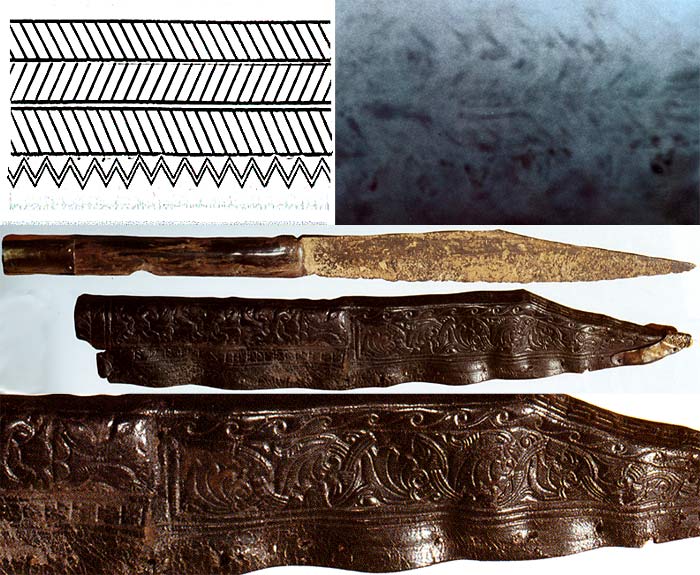
Page 1 of 2
You cannot post new topics in this forumYou cannot reply to topics in this forum
You cannot edit your posts in this forum
You cannot delete your posts in this forum
You cannot vote in polls in this forum
You cannot attach files in this forum
You can download files in this forum
All contents © Copyright 2003-2006 myArmoury.com — All rights reserved
Discussion forums powered by phpBB © The phpBB Group
Switch to the Full-featured Version of the forum
Discussion forums powered by phpBB © The phpBB Group
Switch to the Full-featured Version of the forum